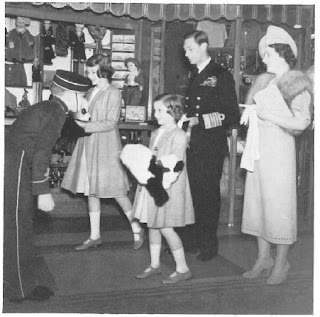The Goodrich Albertines – Part One - An Introduction.
Article from the Wye & Severn Sentinel, October 1938.
Goodrich Court, Herefordshire, mid-October 1938.
“To the east of us is a pocket of insufferable Reds and just beyond them, the forces of our fool of a King and his bullyboy, Moseley. Up in Ross are the Anglican League, who seem to have forgotten this end of the county and are giving all their attention to the fighting in north Herefordshire.
Now the damned Welsh Nationalist traitors have begun raiding us from the west and south. Our sheep, and other livestock, are not safe from their depredations.
We have been left to provide own own defence and we have done that splendidly but our resources are too limited I propose a solution to this.”
After several hours of sometimes heated discussion, Sir Valance Morris introduced an emissary from the Albertine faction.
Inspector McMurdo of the Royal Canadian Mounted Police, looked most impressive in his colourful dress uniform as he took his place next to Sir Valance and spoke with a clear voice:
“Gentleman, and Lady Persephone,
I have travelled across the Atlantic from the Dominion of Canada to offer my help to England and her people in these dark times .
The British Parliament at Winchester has appointed Prince Albert as Lord Protector of this land with a remit to reunite the Empire and remove the taint of both the Fascists and the Reds from the Mother Country.”.
He took a piece of thick paper, bearing a wax seal and ribbon, from the leather folder on the table in front of him and passed it to the local representatives.
“This is an official copy of the instrument of this act, duly signed and passed by the members of the remaining democratically elected Parliament in this country. It calls upon the people of this great nation to support the Prince in returning this land to the status quo of freedom, legality and peace that held firm before this sad outcome began.
Returning Britons and loyal men, and women, of the dominions and colonies are coming to assist you.
The Empire stands with you! You are NOT alone!”
At the end of his short speech, he made the locals an offer of support which they could hardly refuse. He would bring a unit to the area which would significantly increase their defence forces and provide heavy weapons and experienced men.
Another period of intense, and at times heated, debate took place. Not all those present were happy with Morris’s plan. The main leader of the opposition to the proposal, Councillor Rivers, commented that whilst the extra men are needed, there are simply not enough of them to make any real difference to the village’s overall military situation . Also he pointed out that they would need even stronger defences as the presence of the Albertines in Goodrich makes the village a target for other factions in the Civil War and it would be better to say no and keep allow profile to avoid trouble. Eventually, a vote was held and the majority of the representatives voted in favour of Sir Valance and the Albertines.
The strategic position of Goodrich.
Very near to Goodrich, Kerne Bridge and Welsh Bicknor have two railway bridges and a road toll-bridge and Huntsham has a small road bridge which cross the River Wye. These are the only crossing points between Ross and Monmouth. With their hopes of marching their Pembrokeshire contingent to meet with their north-western forces at Tewkesbury, controlling bridges on the Wye means an easier and safer route eastwards out of Wales for the Albertines.
Also, Goodrich forms a good base of operations for the Albertine’s “Special Reconnaissance Section”. From here, their agents can infiltrate central Wales, the Midlands and the Bristol area.
The political boundaries of the area at the end of 1938.
The introduction of another faction into the south Herefordshire / west Gloucestershire / north Monmouthshire area may cause an escalation in the low level fighting locally.
To the north of Goodrich, is Ross-on-Wye which is the base of an Anglican League force that is in a stand off with Royalist/Government and British Union of Fascists units trying to advance west to cut off and surround the Bishop of Ludlow’s men in the north of the county. It is possible that the League’s Ross enclave may be weakened by defections to the Albertine cause.
The strong anti-left wing nature of some of the Albertines (in particular, the Legion of Frontiersmen) will create friction with the communist-led National Agricultural Labourers Union at Hope Mansel and the Independent Labour Party’s Warren James Centuria at Mitcheldean, both a few miles east of Goodrich.
The Gloucestershire Government and BUF commanders are waiting to see if the Albertines fracture the local Anglican League and allow them an opportunity to capture Ross. If not, they may consider a quick strike through to Goodrich to nip this new force in the bud.
The Welsh Nationalists have been raiding the area west of Goodrich and probably will still cause problems for the new faction’s leaders.
To the south at Monmouth and Chepstow are the Royalist Earl of Glamorgan and his men. Rumours abound that some of his men may switch their support from one Royal to another.
We wait with bated breath to see the outcome!




















